Where do morels grow?
They grow in any forest. At the same time, different species prefer certain trees, for example:
- Conical morel, more often found in pine forests, less often in deciduous forests. Prefers felling, shrubs, willows, but can grow in the garden, in the field.
- The gray giant morel is not so whimsical to soil and terrain - it even settles in clay wastelands. It is found in poplar groves and in shelter belts.
Morel cap. Avoids shadows. In early May, it grows in burnt-out areas, glades, near roads.
Growing conditions:
- They love moisture. At high humidity, they grow even in a treeless desert.
- In early spring, when the soil is moist, the mushroom grows in almost any conditions - you can even find it in your own garden or vineyard.
- If you go for a massive harvest of morels, then it is better to look for them in well-lit glades and on scorched terrain.
In good weather, when it is warm and damp, the harvests are enormous. But few people go in the spring for mushrooms. Therefore, morel families often remain intact. Why aren't they collected? Perhaps due to the fact that they are not outwardly attractive, they grow out of season, and most importantly, many are afraid of poisoning. But if you look at the external signs, then it is unrealistic to confuse edible morels with dangerous lines.
A lover of "quiet hunting" tells how the lines differ from morels, how they grow, and how to look for them:
Crochet hat: description and photo (Verpa bohemica)
Morel cap - conditionally edible mushrooms. This is a variety of morels from the Morshell family. They got their name due to the fact that they outwardly resemble real morels, and the mushroom cap resembles a hat.
Synonyms: Morel tender, Verpa czech, Morchella bohemica, cap
Appearance (description)
Morel cap is a large and fleshy mushroom with a height of about 15 cm. A characteristic feature is that the edges of the cap are free. They do not grow with the lower edge to the stem, so it is easy to identify this type of mushroom by its appearance. If you look at the mushroom, it resembles a finger with a thimble on it.
The fruit body grows up to 15 cm tall.
The cap does not grow together with the leg and is attached to it like ordinary mushrooms. The height of the cap is 2-5 cm, the width is 2-3 cm. The shape is bell-shaped, folded. Color - brown or yellow-brown, depends on the area where morel caps grow and their age. The older the fruiting body, the lighter the color. In young individuals, the cap is pressed against the leg, although it fuses with it, and in old individuals, the cap is bent to the side. Outside, the cap is covered with longitudinal folds that resemble a walnut or cerebral convolutions. The lower part is light in color, smooth, delicate and velvety.
The leg is very fragile, cylindrical, narrowed at the sides, 6-10 cm high, 1.5-3 cm thick. They are never even. Young morel caps have a white or light cream-colored leg. The older the mushroom, the darker the stem becomes. With age, it becomes hollow. A slight bloom may be present, which, like a fluff, covers the entire leg. If you touch this gun, then it is easily erased.
Spore powder elongated, smooth, elliptical, yellowish-buffy.
The pulp of a young leg resembles cotton wool. The flesh of the cap breaks very easily. It is waxy and thin.
Smell and taste. Morel hats smell of dampness, although this smell is inexpressive and very light. The taste of ready-made mushrooms is not very pronounced, therefore the mushroom is considered low in quality.
Edibility
If the mushrooms are too contaminated, then they must be soaked in cold salt water before boiling to remove excess dust, sand and insects that could hide in the winding cap.
The morel cap, despite its tenderness and fragility, can be dried, but they should be dried for at least 30 days, and it is better to cook them after 3 months without prior boiling.
It is better not to pick large mushrooms of this type, as they accumulate a large amount of toxic substances that may not collapse during boiling.
Medicinal properties and benefits
There are popular recipes for the treatment of rheumatism with a decoction of morel caps. The benefits of morels for the prevention and treatment of diseases of the visual organs have also been repeatedly reported.
Mushrooms contain vitamins (A, B1, B2, C and D), minerals (potassium, phosphorus, calcium), so they are very useful for the human body if they have been properly prepared and cooked.
Similarities with other species
It is very difficult to confuse the morel cap with other types of mushrooms, since this type of mushroom can be called unique. It differs from other types of morels in that the edges of the cap do not grow together with the leg. As soon as this external sign is established, there is no doubt that this is a Czech verpa or a tender morel.
The main thing is not to confuse these mushrooms with lines, which are poisonous mushrooms.
Morel is the only edible morel
Morel is a conditionally edible mushroom of the Morel family. In another way, the common morel is called edible morel. From the morel family, this is the only representative that is suitable for human consumption.
In Latin, the name sounds - Morchella esculenta.
Description of morel edible
The inside of the mushroom is hollow, so its weight is small. The hat is round in shape, resembling an egg, sometimes morels are found with spherical or flattened caps.
The color of the cap varies greatly depending on various external factors, for example, the age of the mushrooms or where they grow. The longer the edible morels grow, the darker they become.
The cap of the common morel has a rather specific structure: the surface is uneven, wrinkled, with dimples. The pits can be of different sizes, they are lined with hymenium. The cells are irregular, slightly rounded. In addition to the cells, the mushroom has light ribs, which are rather narrow in shape.
The leg is shaped like a cylinder; there is a thickening at its base. The leg breaks easily. The pulp of the mushroom is very fragile, tender and easily crumbles. The color of the pulp is light, close to ocher. Over time, the leg becomes darker. The pulp does not have a pronounced mushroom smell, but it tastes good.
Areas of growth of common morels
Edible morels prefer warm and bright places. These mushrooms grow on soils saturated with lime. Alder, birch, ash and oak forests are perfect for them, in addition, they grow in forests mixed with needles.
Among the fallen leaves, it is not easy to notice the common morel, since its masking color allows it to remain invisible. Most often, these mushrooms grow alone.
Where and when are edible morels harvested?
Common morels are quite rare mushrooms, although they are the most common among other morels. They are collected on lawns and forest edges with grass cover. In the south of Russia, they can be found directly in the garden or vegetable garden.
You can go in search of morels at the end of April, but the early morels are more watery and have a vague smell. In May, they become stronger and take on a real mushroom aroma with a light fruity note. In the middle lane, there are much less April morels than May morels. Some specimens can be found even at the beginning of June.
Also edible morels appear in parks and gardens of large cities. These mushrooms even grow in Australia. In the United States, they are expensive, there is even a Society of Morel Lovers, whose representatives call morels "kings of mushrooms."
How dangerous can morels be?
Morels, like stitches, contain a dangerous substance called gyromitrin. But there is much more of this substance in the lines than in morels or morels. Some researchers are confident that morels grow in many areas, which do not contain the toxin.
In any case, it is recommended to pre-scald, but it is better to boil morels, and then drain the water. In this case, the mushroom will delight you with its taste and will not cause any harm.
A dangerous resemblance, or how to distinguish an edible morel from a line?
Some mushroom pickers confuse morels with their poisonous cousins.
Indeed, related species are very similar, but they can be distinguished by their shape, it is worth paying attention to the fact that the cap of the edible morel is round, in addition, its size is larger than that of poisonous species
In the morel, the length of the cap and the legs are almost the same, and in the stitching, the leg is often shortened, sometimes it is not visible at all.
In morels, both the cap and the leg are hollow inside, and the lines are filled with sinuous pulp. There are sinuous cells on the surface of the morel.
Edibility of common morels
In our country, these mushrooms are allowed for harvesting. These are conditionally edible mushrooms, they must be boiled beforehand. You can also dry morels.
We treat these mushrooms with caution, since from time to time there is information about cases of poisoning with morels.
But this is due to improper preparation of mushrooms or the fact that poisonous lines are often sold in the markets instead of morels.
Edible morels in any form are a great treat.
Is there a difference in cooking morels and stitches?
Morels are conditionally edible mushrooms. They can only be eaten after being cooked. They contain a little toxic substance - hydrozine. The method for preparing stitches and morels is similar:
- Morels. They can only be cooked after boiling. Cooking time is 15-20 minutes. Also, the fruiting body of the fungus is deprived of toxin when dried - therefore morels can be dried. They are boiled in salted water. The broth is poured, the mushrooms are washed in running water. After that, the mushrooms are ready for further culinary processing - they can be fried, stewed, pickled, frozen. The boiling procedure for morels is required for any form of mushroom preparation; they are not boiled just before drying. Morels are not recommended for first courses - they lose their taste and aroma. Morels are also used to make a powdery seasoning!
-
Lines. They are certainly boiled. There are lines or not there - everyone chooses for himself. Scientists have found strong toxins in the lines, but many people still collect and eat these spring mushrooms. Mushroom processing conditions:
- For 1 kg of mushrooms, take 6 liters of water. For 100 g - from 2 liters.
- A pinch of soda is thrown into the boiling water. And only then mushrooms.
- After boiling the mushrooms for 20 minutes, the water is drained. The boiled lines are washed.
- Unlike morels, the lines are boiled twice.
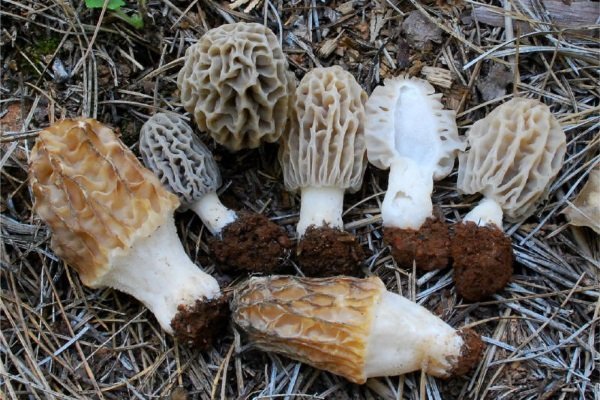
The lines, like morels, can be dried. Those and other mushrooms cannot be eaten immediately after drying - you must wait at least a month. In the oven, the lines dry for an extremely long time. The temperature is set to +55 degrees. The lines dry in the air for up to six months.
Morels and stitches have a lot in common, but knowing their distinctive features, you can easily tell these mushrooms from each other. If "quiet hunting" is your hobby, you should be armed with the knowledge to help you recognize danger.
1
Fruit body composition and recipes
Morel caps are usually referred to as conditionally edible species, suitable for consumption after cooking. Boil the mushroom over high heat for at least 10 minutes. The cap is equally suitable for boiling, frying, freezing, salting, pickling, stewing and drying.
In addition to toxins that are easily removed by cooking or drying, the fruit bodies of the morel cap contain a rich set of vitamins and minerals:
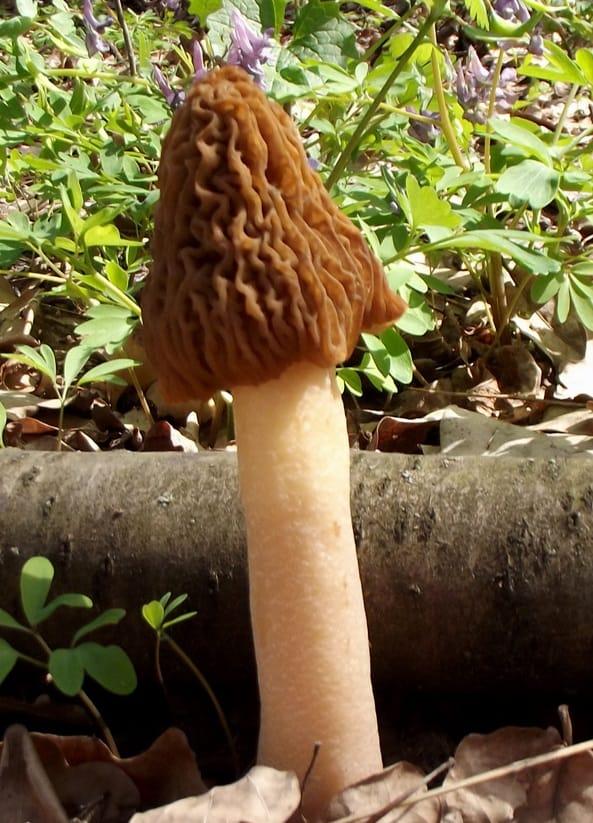
- phosphorus;
- potassium;
- iron;
- phosphorus;
- zinc;
- calcium;
- vitamins C, D, B1, B2, A.
100 g of fresh fruit bodies contain:
- water - 92 g;
- proteins - 3 g;
- fats - 0.4 g;
- carbohydrates - 0.2 g;
- fiber - 0.7 g
Primary processing
To begin with, the collected fruit bodies are cleaned of grains of sand and a large number of insects that may remain inside the folds of the cap. To do this, they are soaked in cold salted water for several hours, and then washed under a stream of boiling water. Worms can be found in mushrooms collected in the southern regions.
Cooking
Boiling the caps takes at least 10-15 minutes. In the process, the water is drained at least 4-5 times so that it can pick up as much of the poison as possible. The boiled pulp softens, becomes tender in taste.It is best to use dried mushrooms for soups.
Pickling
For pickling you will need:
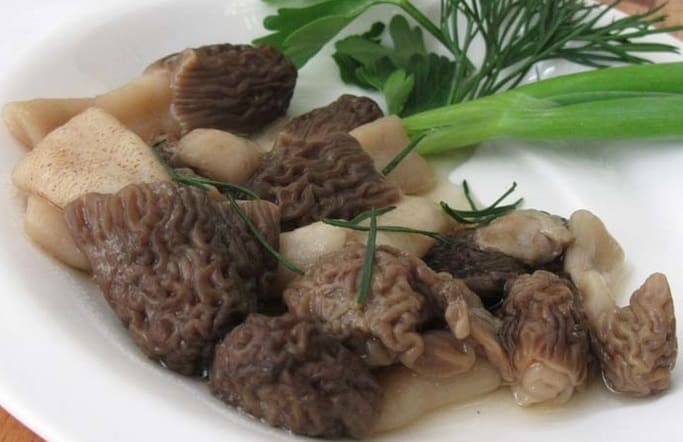
- mushrooms - 1 kg;
- 6 percent vinegar - 3 tablespoons;
- citric acid - a third of a tsp;
- sugar - 1 tbsp. l .;
- salt - 1 tsp;
- seasonings: bay leaf, black pepper, optional - cinnamon, cloves.
Procedure:
- Boil the caps for 10-15 minutes in salted water.
- Then the marinade is boiled: spices, citric acid, sugar and salt are added to a saucepan with water, everything is brought to a boil and cooked until sugar and salt are completely dissolved.
- Vinegar is added to the finished marinade, then poured into prepared jars and canned.
Salting
Caps are salted hot. To do this, take the following products:
- mushrooms - 1 kg;
- food salt - 50 g;
- spices: dried dill, peppercorns, cloves, currant leaves.
Procedure:
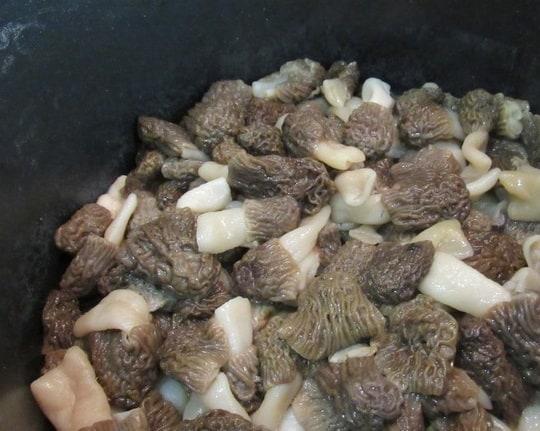
- Mushrooms are soaked in salted water and boiled for 10-15 minutes.
- The water is drained, the fruit bodies are re-boiled in salted water, after boiling, spices are added.
- After the mushrooms sink to the bottom, the water is drained, the caps are allowed to cool and they are placed in glass jars.
Drying
Drying of morel caps should take at least a month. During this time, toxins, as a rule, have time to disintegrate on their own.
Appearance
The hat has a wrinkled surface. Its dimensions can range from 2 to 6 cm in height, and its width is 1-4.5 cm. The color of the cap changes with age. In a young mushroom, they have a dark brown tint. But in an adult it is lighter, turns yellow or ocher. With the leg, it grows together only at the top, and in the lower part, its surface is smooth, has veins.
The leg is bent. Its length can be up to 14 cm, but most mushrooms have a stem 5-10 cm long. It is cylindrical in shape, but sometimes flattened. Its thickness is 2-3 cm. The old mushroom has hollow legs. Young morel caps have flesh in the stem that resembles cotton wool in consistency and has a yellowish color.
Among the mushrooms, morels also include species such as common and conical morel. They are conditionally edible.
Places of distribution and period of fruiting
Morel cap is found everywhere in the temperate climatic zone in the Northern Hemisphere.
Morel hats are found by fans of "quiet hunting" often in well-lit deciduous and mixed forest belts under young aspen and linden trees (less often - birches), in lowlands, on wet loams and sandy loams, they like to settle near streams, next to ditches. If there is little moisture, then the mushrooms die quickly.
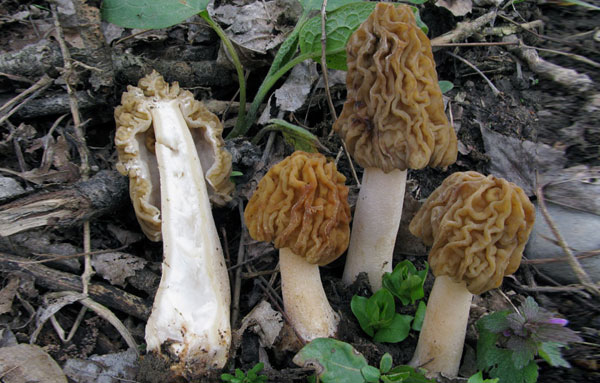
Caps bear fruit in spring from March-April to late May, often in large groups. But the collection period is limited to 2-3 weeks, then the mushroom disappears until next year.
The main sign that it is time to go to the forest for morel caps is the "earrings" on the aspens. Interestingly, the Czech verp, depending on its age, most likely can be both a mycorrhizal forming agent and a saprotroph.
Description
The fruiting bodies (apothecia) of the morel cap are large, fleshy, up to 10 cm or more in height, usually described as caps.
The cap of the mushroom is in the form of a cap (bell-shaped, thimble-shaped or conical), small - 1-5 cm in height and 1-4 cm in diameter. Unlike morel caps, the lower edge of the cap is free (the cap grows to the stem only at the very top); in young mushrooms, it is pressed against the stem, in old ones, it is often bent to the side. The color of the cap also depends on the age of the mushroom and the place of growth, changing from brown, dark brown (in young mushrooms) to yellowish-ocher and even yellow (in mature mushrooms). Outside, the surface of the cap is wrinkled, covered with many small sinuous longitudinal folds, sometimes branching; in old mushrooms it looks pitted. Below the cap is smooth, lighter, with many whitish veins arranged in circles.The stem is long, cylindrical, smooth, sometimes slightly grooved, usually curved, often slightly flattened laterally, slightly widening towards the base, 6-11 (up to 15) cm long and 1.5-2 (up to 3) cm thick. In young mushrooms, the leg is whole inside, filled with cotton-like pulp; in mature mushrooms, it is hollow. The color of the stem also changes with age: in young mushrooms it is white-yellowish, in mature it becomes ocher. The surface of the leg is pubescent or slightly scaly, covered with a fine powdery coating, located in thin belts, which is easily erased from touch. The pulp is light (darker at the cap), very brittle and thin, waxy, with a specific odor, similar to the smell of dampness and without a particular taste.
Fruit bags contain only two ascospores. The spores are large: 54–80 × 15–18 µm, smooth, elongated-ellipsoidal, without oil droplets. Spore powder, yellowish.
Fruit body composition and recipes
Morel caps are usually referred to as conditionally edible species, suitable for consumption after cooking. Boil the mushroom over high heat for at least 10 minutes. The cap is equally suitable for boiling, frying, freezing, salting, pickling, stewing and drying.
In addition to toxins that are easily removed by cooking or drying, the fruit bodies of the morel cap contain a rich set of vitamins and minerals:
- phosphorus;
- potassium;
- iron;
- phosphorus;
- zinc;
- calcium;
- vitamins C, D, B1, B2, A.
100 g of fresh fruit bodies contain:
- water - 92 g;
- proteins - 3 g;
- fats - 0.4 g;
- carbohydrates - 0.2 g;
- fiber - 0.7 g
Primary processing
To begin with, the collected fruit bodies are cleaned of grains of sand and a large number of insects that may remain inside the folds of the cap. To do this, they are soaked in cold salted water for several hours, and then washed under a stream of boiling water. Worms can be found in mushrooms collected in the southern regions.
Cooking
Boiling the caps takes at least 10-15 minutes. In the process, the water is drained at least 4-5 times so that it can pick up as much of the poison as possible. The boiled pulp softens, becomes tender in taste. It is best to use dried mushrooms for soups.
Pickling
For pickling you will need:
- mushrooms - 1 kg;
- 6 percent vinegar - 3 tablespoons;
- citric acid - a third of a tsp;
- sugar - 1 tbsp. l .;
- salt - 1 tsp;
- seasonings: bay leaf, black pepper, optional - cinnamon, cloves.
Procedure:
- Boil the caps for 10-15 minutes in salted water.
- Then the marinade is boiled: spices, citric acid, sugar and salt are added to a saucepan with water, everything is brought to a boil and cooked until sugar and salt are completely dissolved.
- Vinegar is added to the finished marinade, then poured into prepared jars and canned.
Salting
Caps are salted hot. To do this, take the following products:
- mushrooms - 1 kg;
- food salt - 50 g;
- spices: dried dill, peppercorns, cloves, currant leaves.
Procedure:
- Mushrooms are soaked in salted water and boiled for 10-15 minutes.
- The water is drained, the fruit bodies are re-boiled in salted water, after boiling, spices are added.
- After the mushrooms sink to the bottom, the water is drained, the caps are allowed to cool and they are placed in glass jars.
Drying
Drying of morel caps should take at least a month. During this time, toxins, as a rule, have time to disintegrate on their own.
It is interesting: Herb hibiscus - planting, growing and care, photo
How to grow a mushroom yourself?
First you need to choose a suitable place, it must be sunny, on an elevated site. Loamy or sandy loam soil is best suited. To make it convenient to care for and collect mushrooms, they allocate a lot of space: 1.5 meters in width, and any length.
In order for the mushrooms to take root well, a clear sequence should be followed:
- Small pieces of rotten apples are spread on the surface.
- Further, right on the soil where mushrooms will grow, cardboard or paper is burned and ash is scattered over all the beds.
- Then the ground is watered.
- The next step is to sprinkle with pre-prepared mycelium.
- Cover with a 5 cm layer of forest floor.
- Fir spruce branches are sprinkled from the very top (chopped straw is also suitable).
Care is as follows: constant soil moisture, and next spring the cover should be removed. Mushrooms come out of the ground the next spring after sowing. About two kilograms of mushrooms come out from 1 square meter. Once the mushrooms have been harvested, the beds are re-covered and moistened from time to time. Every year, the beds should be sprinkled with the same apples and burned paper or cardboard. If everything is done correctly, then mushrooms can bear fruit for about 5 years in a row.
The morel cap, although not attractive in appearance, is an edible mushroom, in some way even considered a delicacy. This type of mushroom can be grown at home, but for this you need to try and follow all the rules.
Similar species
Morel is real
All morel mushrooms are more or less similar to the morel cap, but they are easily distinguished by the presence of a leg on which the cap sits freely and is detached without effort.
An inexperienced mushroom picker may mistake some types of stitches for a morel cap, but upon closer examination it is clear that the shape of the cap in the stitches is completely different, more chaotic with large convolutions of folds, when, like in morels, there is some orderliness in the pattern of convolutions.
Well, the most obvious difference is that in the lines the leg is practically spliced with the cap, while in the morel cap they are connected quite loosely.
Description of morel cap
Morel cap is a large fleshy mushroom. A characteristic feature of the mushroom is loose dyeing caps. The color of morel caps is very different, depending on the age of the fruiting body.

In young specimens, the color is more brown and dark, the larger the mushroom becomes, the lighter its color becomes. Also, the color of the fungus can be influenced by the terrain where it grows.
The cap is wrinkled, covered with deep longitudinal folds that resemble convolutions. The hat looks like a walnut. The lower part of the cap is lighter, softer and smoother.
The leg is never even, its shape is cylindrical, mushrooms with noticeably curved legs, strongly narrowed at the sides, are most often found. In mature mushrooms, the legs are hollow. The pulp of young mushrooms resembles cotton wool. The leg, like the cap, changes with age. In young morel caps, the legs are lighter, the older the mushroom gets, the darker the leg becomes. The surface of the leg may be covered with light bloom or fluff. When touched, this plaque is immediately erased.
Light mushroom flesh breaks easily. Its structure is waxy, very thin. The pulp has a specific smell of dampness.
Places of growth of morel caps
Most often, morel caps are found on flooded soils in the temperate northern zones. These mushrooms grow on moist soil in spring. If the soil is not too wet, morel caps dry out quickly and die. Due to this, they most often settle near streams, ditches and pits with water.
Morel mushrooms live in aspen, linden or birch forests. They often bear fruit in large groups. They are distributed from the northern foothills of the Caucasus to the southern borders of Karelia. Mushroom pickers of Russia are very fond of morel hats. It is recommended to look for them in deciduous moist forests with a predominance of aspen, poplar, alder, linden and birch. At the same time, they grow among aspens aged 30-40 years, and among young and very old aspens they come across less often.
Morel caps are rather picky about the soil, they give preference to black soil, sandy loam soils covered with leaf litter and sour loam. If the spring is too dry, cold or too damp, then morel caps bear little fruit. The fruiting times of these mushrooms are often short. They bear fruit from the beginning of May to its middle, while growing rapidly, gaining spore strength, and quickly perishing.
In the northern parts of the range, these fungi are practically not affected by the larvae, but in the southern regions mushroom pickers can often find worms in these mushrooms.






